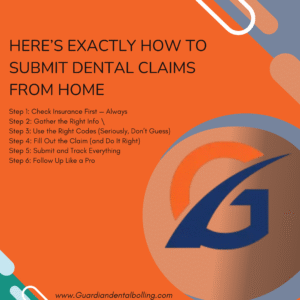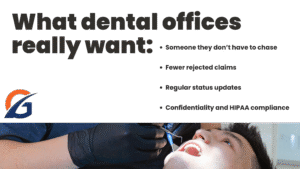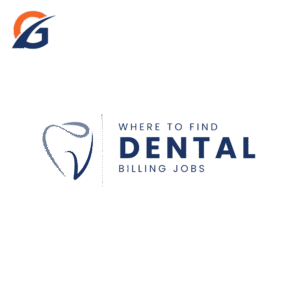If you’re working as a remote dental biller or planning to become one, there’s one thing you absolutely can’t afford to get wrong: claim submission.
You might be sitting at your home office in comfy clothes, but your job is just as crucial as someone at the front desk of a dental clinic. Every claim you send out is directly tied to whether that office gets paid — or ends up chasing insurance companies for weeks.
In this guide, let’s walk through how to submit dental claims properly, avoid rejections, and become the kind of remote biller that every dental office wants on speed dial.
Why Claim Submission Isn’t Just Data Entry
It might look like you’re just filling in forms or hitting “submit” — but trust me, it’s way more than that.
Your role as a remote biller touches three important areas:
- Insurance accuracy — making sure the patient’s coverage is valid and up to date
- Coding clarity — selecting the correct procedure and diagnosis codes
- Payment flow — helping the office get paid faster and cleaner
And when you’re doing all this from a distance? You’ve got to be even more precise.

Here’s Exactly How to Submit Dental Claims from Home
Let’s break it down into practical steps — the same way you’d do it if you were sitting right there in the dental office.
Step 1: Check Insurance First — Always
Before the patient even opens their mouth, you need to know: Is their insurance active? What’s covered? What’s not?
Don’t rely on what’s in the system. Log into the portal or call the insurance company and double-check the basics:
- Is the plan still active?
- Have they hit their maximum for the year?
- Is there a waiting period on the procedure?
- Does the plan cover out-of-network providers?
Keep those answers documented in the patient’s chart. It’ll save you a ton of headaches later.
Step 2: Gather the Right Info
You’ll need more than just the patient’s name and birthday.
Make sure you’ve got:
- The dentist’s NPI and Tax ID
- The correct CDT codes for each procedure
- Tooth numbers and surfaces (if needed)
- The exact treatment date
- Any necessary attachments (like X-rays)
Small errors here — even just a typo — can cause claims to bounce back. And yes, insurance companies are that picky.
Step 3: Use the Right Codes (Seriously, Don’t Guess)
This is where a lot of new billers slip up.
Every dental procedure has a CDT code. Some also need an ICD-10 code, especially if you’re submitting to medical insurance.
Check the most updated codebook, not last year’s version. Use proper modifiers only when absolutely required — and never guess.
Wrong codes = denied claims. And denied claims = unpaid work.
Step 4: Fill Out the Claim (and Do It Right)
Most of the time, you’ll be submitting claims electronically. But whether it’s paper or digital, here’s what matters:
- Double-check all personal and insurance details
- Make sure the provider info is accurate
- Attach any needed documents (narratives, X-rays, perio charts)
- Include total charges and who’s responsible (insurance vs. patient)
If you’re using a system like Open Dental, Dentrix, or Curve, this part is easier — but don’t let automation make you lazy.
Example: When to Use a Narrative
“Crown recommended on #30 due to fractured cusp and decay beneath the existing filling. Patient has symptoms and fracture is visible on bitewing X-ray.”
Short, clear, and to the point — that’s what insurance reps want to see.
Step 5: Submit and Track Everything
Once you hit “submit,” your job isn’t over.
Log the date of submission, note the claim ID or batch number, and keep track of when you expect a response.
Use a tracker. Even a simple Excel sheet works if your software doesn’t handle it well.
Keep columns for:
- Patient name
- DOS (date of service)
- Submission date
- Expected payer response
- Payment posted / denial reason
That way, when something gets held up, you’re not scrambling to figure out what happened.
Step 6: Follow Up Like a Pro
Claims don’t always get processed smoothly — even when you do everything right.
Here’s when to call:
- It’s been 2–3 weeks and there’s no response
- The claim was rejected with no clear explanation
- Insurance says they never received it (yes, it happens)
When you call, always write down:
- The rep’s name
- The reference number for the call
- What they told you
This kind of note-taking builds trust with your client — because when they ask what’s happening, you’ll have answers.

Common Mistakes Remote Billers Must Avoid
Even experienced billers make these slip-ups — but they’re easy to fix once you spot them.
Submitting with Old CDT Codes
CDT codes change every year. If you’re using outdated codes, you’re setting yourself up for denials.
Forgetting Attachments
Some claims (like crowns or SRPs) need X-rays or perio charting. No attachments = no payment.
Wrong Insurance Details
Double-check the group number, policy number, and payer ID. You can’t afford a mistake here.
Submitting Too Late
Many insurances have a 90-day submission window. Miss it, and the claim is dead — no appeal possible.

Best Tools & Software for Remote Dental Billing and Claim Management
These aren’t optional — they’re essentials if you want to stay organized and efficient:
| Tool | What It Does |
|---|---|
| Practice software (e.g. Open Dental, Dentrix) | Handles patient info + claim generation |
| Clearinghouse (e.g. DentalXChange, Vyne) | Submits and tracks claims |
| Insurance portals (MetLife, Aetna, Guardian) | Lets you verify and follow up claims |
| Google Sheets or Excel | Manual trackers, logs, audit trails |
| Adobe / PDF tools | Scan + compress X-rays or narratives |
How to Succeed and Stand Out in Remote Dental Billing Jobs
You’re not in the office. You’re not face-to-face with the doctor. So how do you prove your value?
You submit clean claims. You follow up professionally. You catch mistakes before they become denials.
What dental offices really want:
- Someone they don’t have to chase
- Fewer rejected claims
- Regular status updates
- Confidentiality and HIPAA compliance
Be that person — and you’ll never struggle to find work

Where to Find Remote Dental Billing Jobs
If you’re still building your client base, try:
- DentalPost.net
- Indeed.com (search “remote dental biller”)
- Facebook groups like “Dental Billing Remote Jobs”
- Upwork and Fiverr (start small, build trust)

What Clients Are Looking For:
Software experience (especially with their PMS)
Knowledge of claim submission and follow-up
Clean work habits
Great communication

Remote Dental Claim Submission FAQs: Accuracy, Reputation, and Getting Paid
You might not wear scrubs or greet patients — but you’re the reason a dental office gets paid. Every clean claim you submit says something about your work ethic.
So take your time. Pay attention to details. Track everything.
Because when you’re a remote biller who makes life easier for your clients — word gets around.
Remote Dental Billing FAQs: Claim Submission, Insurance Portals, and Common Mistakes
- What is a dental claim, and why is it important?
A dental claim is a request sent to an insurance company for payment on services provided to a patient. Submitting clean, accurate claims ensures the dental office gets paid faster and avoids unnecessary denials. - Can dental billers work remotely?
Yes, many dental billers now work entirely from home. As long as you have the right software, training, and communication skills, remote billing is not only possible but also highly in demand. - What information is needed to submit a dental claim?
You’ll need the patient’s demographics, insurance details, provider information, correct CDT codes, treatment dates, and any necessary attachments like X-rays or narratives. - How do I verify insurance eligibility remotely?
Use insurance portals, clearinghouses, or call the payer directly to check if the patient’s plan is active, what it covers, and any limits or waiting periods. - Which software is used for remote dental billing?
Popular platforms include Open Dental, Dentrix, Eaglesoft, Curve Dental, and clearinghouses like DentalXChange or Vyne for claim submission and tracking. - How long does it take to get a response after submitting a dental claim?
It varies by insurance, but most electronic claims are processed within 7 to 21 business days. Always follow up if you haven’t heard back in 3 weeks. - What are common reasons dental claims get denied?
Claims often get denied due to incorrect patient info, wrong codes, missing attachments, expired plans, or lack of medical necessity documentation. - Do I need a certification to work as a remote dental biller?
While certification isn’t legally required, having credentials (like from AAPC or dental billing courses) can make you more competitive and trustworthy to employers. - Can I use spreadsheets to track my claims?
Yes. Many remote billers use Excel or Google Sheets to track submissions, follow-ups, and payment statuses — especially if their practice management software lacks built-in reporting. - How can I get better at submitting clean claims?
Study CDT codes annually, build a checklist for each claim type, stay updated on payer requirements, and always review before hitting submit. Over time, clean claims will become your habit.

